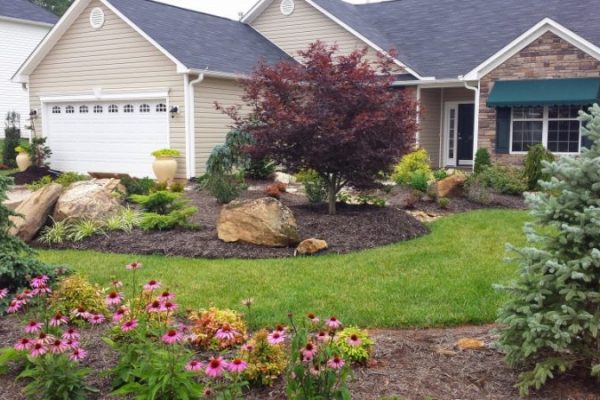Tiling is a great way to transform your outdoor living space. It has the longest durability necessary to withstand weather and humidity, and it is easy to clean and maintain. Proper tile design can complement your landscaping elements to add beauty and sophistication to your patio, pool, or deck.
There is an endless variety of outdoor tile options. Each type is really different and can only work in certain spaces and for specific uses. So, how would you choose the suitable ones? Well, this guide will give you the information and advice you need on the best outdoor tile options, as well as much more, to get you started.
Table of Contents
Porcelain Tiles
One outdoor tile option that offers a lot of versatility is porcelain tiles. They are also incredibly suitable for the outdoors. Using extremely high temperatures during the manufacturing process helps produce tiles that are stronger and denser than materials such as ceramics and even certain types of natural stone.
Because they won’t rot or stain, and they have such a low water absorption rate that they’re almost waterproof, it’s not hard to see why so many people choose to install them in outdoor places. They are also resilient to freezing temperatures, which can be very important, depending on where you live. Many consumers do not realize that porcelain tiles can be used as substitutes for stone and other materials.
Since porcelain can absorb stain so well, it can look like a real stone, which would generally cost much more. Adding stone-like outdoor porcelain tiles is a good idea for someone who likes the look of natural materials but wants something less expensive, and low-maintenance. When purchasing, you should be sure to check the PEI rating of the tiles you are considering, which will tell you how they can be used. This is a hardness and durability rating established by the Porcelain Enamel Institute.
Wood-Look Decking
Probably the most versatile outdoor tile option in terms of appearance. Composite wood decks can give your patio floor a rustic, intimate look or a sleek, polished, and modern look. Besides, wood never goes out of style, making wood decking an option that will never go out of style.
Consider these tiles as a more modern and economical version of traditional wooden boards. These tiles give you the most sought after “wood look” without the weight and pain of installation. And they are magnificent!
The wood-look deck offers you the best of both types. With modern technology, you can achieve a beautiful and realistic wood look without the challenges of traditional wood. Composite flooring is like luxury vinyl in the porch flooring market. Perhaps some outdated people still turn their noses, but others adopt composite decks as the exterior floor of the future. Composite decks, like vinyl flooring, give you a real wood-look with no problems.
Quarry Tiles
Although they don’t actually come from quarry stone as they did in the past, these unglazed clay tiles are very strong, and work extremely well as outdoor tiles for patio use. Unlike ceramics and porcelain, quarry tiles are usually only found in a few colors. Very often they are seen in red, but sometimes also in brown or gray.
It is these deep, rich, earthy colors that help quarry tiles represent a unique Mediterranean look that many homeowners love. These tiles are also much thicker than the other types that make it an extremely durable and solid tile that can resist abuse from the outside. Quarry tiles also have a very low rate of water absorption, which allows the owner to use them in wet areas.
However, they must be sealed so that they do not absorb stains. Quarry tiles can be more difficult to clean than other types of tiles and can sometimes require good pressure washing.
Ceramic Tiles
Ceramic can withstand mild weather conditions and light outdoor use, but it is not as strong as other types of outdoor tile. For this reason, you should only choose ceramic for covered terraces or terraces that do not see many extreme weather changes.
And remember, not all ceramic tiles are created equal. Some types are weaker or stronger than others, so be sure to choose a sustainable option. Depending on what you buy, ceramics may be an affordable option. Still, there is a lot of flexibility in the price range.
Limestone
Limestone is a softer, more porous stone, so these tiles will need to be sealed to protect them from stains and weathering. It also shows easy wear, so they are not recommended for high traffic areas. They also tend to crack during cold winters. The distinctive pits in the stone create an unusual texture that limestone lovers cannot resist.
Limestone is a pale stone, with colors ranging from white to brown. Polished limestone tiles can become slippery when wet. Still, there are slip-resistant versions for terraces near pools and patios that are not protected.
Travertine Tiles
Travertine is a kind of natural stone with stunning texture and color. Considered a form of limestone, this stone is extracted around natural mineral deposits from sources. Although it is very attractive and hard, it has a slightly pitted surface that can collect dirt unless it is polished.
Highly polished travertine can be slippery when wet. The quality of these tiles varies significantly, depending on where it was extracted. For use on the terrace, travertine from Turkey or Italy is considered a more waterproof option than stone from Mexico or China.
Concrete Tiles
Concrete tiles offer you a more economical way to get a natural-stone outdoor floor. Manufacturers mold concrete to the right texture and color it to look like natural stone. This gives your home an upscale look for a fraction of the cost.
Concrete tiles are durable and can withstand adverse weather and heavy traffic. However, you will have to close it every few years.
Final Thoughts
Outdoor tiles can significantly affect the appearance of any outdoor space. Different types of exterior tiles also have different strengths and weaknesses. Thinking about your tastes, lifestyle, and location will help you choose the right outdoor tiles for your patio or deck.











